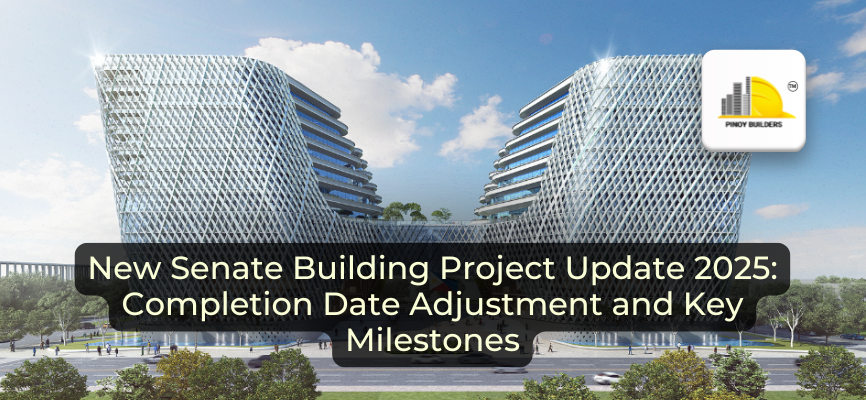Featured Builder of the Month is our periodical feature of inspiring fresh faces in the construction industry. Do you have a worthy Featured Builder in mind? Send us your recommendations at pinoybuilders2019@gmail.com.
“Be inspired by the future because it is something that will drive you to wake up everyday in the morning. It is not all about the money. Sometimes, you just have to talk about the impacts.”
As many would imagine, being a civil engineering student is not easy. Most believe the course itself consists only of math, endless calculations, and boredom. In a way, it is like how people view concrete— as an essential aspect of society, but rather unexciting to look at.
But as with most things, beauty is in the eye of the beholder, and having the right perspective is important in understanding what makes it intriguing to its dedicated professionals. It is more than just a paycheck for many engineers, and for Angelica Munar, it is a passion – a course that sates her thirst for knowledge! In fact, it is her unabashed optimism that carried her to the international heights with the American Concrete Institute (ACI) Spring 2019 Convention in Canada.
Get to know Engineer Angelica Munar and find out how someone can fall in love with the world of civil engineering.
What led you to pursue civil engineering?
Si lolo talaga ang inspiration ko, though electrical engineer siya. Ang mahirap kasi sa electrical engineering, hindi kasi kita ang kalaban, whereas compared to civil engineering, it’s all about the horizontals and the verticals.
As a career goal naman, grade school ko pa ginusto maging engineer because I was into Mathematics, which showed when I participated in annual competitions. I thought about pursuing other fields but at the end of the day, engineering pa rin ang goal ko. Iba pa rin ang first love!
How was your university life in UP?
The thing I like most during my years in UP is that you are free to do anything so long as tama siya. I was part of the UP Dance sport Society and UP Dance Ensemble at the time, and it was also a way for me to relax and forget about academics-related stress from time to time. Sa civil engineering life ko, nakakapagod din, especially with the competitions.
With the ACI Eco-Concrete Competition, halos kami na yung naghalo at nagbuhat ng gamit kagaya ng gravel, sand, semento, and so on. Minsan inaabot kami ng gabi, tapos kapag break time, madalas one and a half-hour yung duration bago bumalik sa laboratory or classroom. Despite the hardships, it was all really fun!
What can you tell us about the American Concrete Institute?
The ACI is an international organization that focuses on concrete design and development. They start working at a collegiate level wherein there are student chapters in different colleges, like in UP and the University of Santo Tomas. Under the ACI-Philippines is the Federation of Student Leaders, an organization for national level collegiates. Both are behind all national concrete competition events since ACI does not only consist of students alone but international experts and enthusiasts from all around the world.
A short introduction on what the ACI-PH Federation of Student Leaders is.
The national concrete competition was a good experience because the ACI-Philippines wanted us to socialize with students from other universities since tayo tayo lang naman din yung magkakakita sa field. It is a bit different from my experience with the ACI International, where you will be exposed to innovations and technologies from all over the world. Going there, you will realize na marami ka pa palang hindi alam, so it was really a humbling experience. It will push you to go beyond researching techniques.
How did you guys prepare for the ACI Eco-Concrete Competition?
The goal of the competition was to develop an innovative concrete mixture, which will have the lowest possible environmental impact while maintaining optimal performance. The parameters involved were strength, durability, and sustainability through a Life Cycle Assessment. The defense, presentation, and the paper were also part of the grading process.
There were a couple of notable difficulties early on because the laboratory we were using was lacking in facilities. This forced us to do a lot of the concrete production process manually. At the start, we needed a viable cement alternative, so my groupmates, Alexis Declaro, Paulo Santos, and Ryan Ramelo, as well as our coaches, Prof. Justin Seranilla and Prof. Christian Orozco, decided to go with the pozzolan rocks that were available around the campus. It took us approximately 500 concrete cylinders and 9 months to prepare for the competition.
The team holding their winning concrete cylinders.
How many teams participated in the competition?
There were 25 teams from all over the world. We were the last to defend our work. So, during our defense, one of the items they were curious about was our transportation cost (of the pozzolan), and why it was zero. We had to explain the origin of the Pozzolan we used and the circumstances that led us to using it. I believe it’s one of the reasons we got ahead of the competition. Since sa campus lang siya nanggaling, maliit ang CO2 emissions! Tapos kami na rin nag crush ng bato manually.
Speaking of manual work, we also had to explain in detail the difficulties we had in testing the durability of the concrete. We needed a very specific kind of equipment for the process, but unfortunately it was not available in the Philippines at the time. In the end, we decided to take matters into our own hands and build the equipment ourselves. It was a grueling defense, but we managed to pull through!
How was the banquet ceremony?
Almost a thousand were present from all over the world. Nang dumating na sa announcement of winners, straightforward lang sya. Walang build-up, walang kaba-kaba. Laking gulat namin nung nakita naming apat yung mukha namin sa screen. Kung tutuusin, ang pangarap lang namin nung una ay magkaroon lang ng tarpaulin sa campus pagkauwi. Placing first was an honor!
What are you excited for in the industry and what innovations are you keeping an eye on?
I actually want to study more about self-healing concrete. It is a durable alternative in the long run because of its self-healing properties, but the strength is, of course, lower, so the industry needs to study more about that. I also want to delve into self-compacting concrete, which we found out is popularly used in Japan, which explains the speed in which they fix road damages caused by earthquakes.
Photo of a concrete road in Japan that was repaired within six days. Photo courtesy of the Daily Mail.
On alternative concrete tech, I’m keen on focusing on pineapple fiber leaf reinforcement or PALF, because I’m curious as to how durable it is, how they cure it, and deterring possible long-term degradation in the future.
Do you think the PH can adopt these advancements and alternatives in the future?
Yes, but we also have to research it thoroughly. We have a lot of students and researchers looking into the viability of recycling waste, like demolition debris, for concrete use. Fly Ash, rice husk ash, we can also use these for concreting. Even self-compacting, we can adopt these technologies but alongside thorough studies. Ang gamit kasi natin ay ACI Concrete Standards, which is what they teach in school and what we use in the industry.
Example of demolition debris.
What should the industry do to reduce its environmental footprint?
The main point na natutunan ko sa sustainability ay yung life cycle assessment. This starts with the procurement, then assembly, production, and the end of life factor. For concrete, mas maganda kung magkakalapit lang yung components at kung saan siya ginagawa. Mayroon din mga concrete alternatives that you don’t need to heat. Cement kasi, to make it into regular cement, you have to heat it at like 1350°C. We can opt for alternatives we can heat at 850°C but with the same strength. Sustainability is not just about the materials used in creating a healthy alternative, but also the process of creating it as well.
Do you think the industry will one day move on to 100% healthier concrete alternatives?
Wala po talaga tayong choice kung hindi maghanap ng alternatives kasi pag naubos ang mountains natin, well. Thankful lang ako at mas nagiging aware na ang tao at nagsisimula nang maghanap ng initiative to look for innovations (like eco-concrete) concerning sustainability. Going from 100% cement to a 100% alternative is not impossible, but it might take us decades or even a century to perfectly reach 100%. Since as of now, we are taking into account the optimum replacement of each alternative component for it to be as effective, if not more, than the regular version.
Any words of wisdom for young hopefuls looking to become licensed engineers in the future?
Winning smiles!
For the young engineers, students, and undergrads, just keep going. I believe you will reach a point na you will have zero knowledge about anything, which is applicable to every other course. Keep going because it is normal to get to a point like that.
Also, believe in yourself. Don’t be the one to place limitations on yourself. When you do that, ikaw rin ang makakaapekto sa growth mo. Be optimistic! You have no idea of your capacity, so go out of your comfort zone and face your fears kasi lahat naman tayo may kinakatakutan.
Padayon!
*This interview has been edited for brevity
![]()








